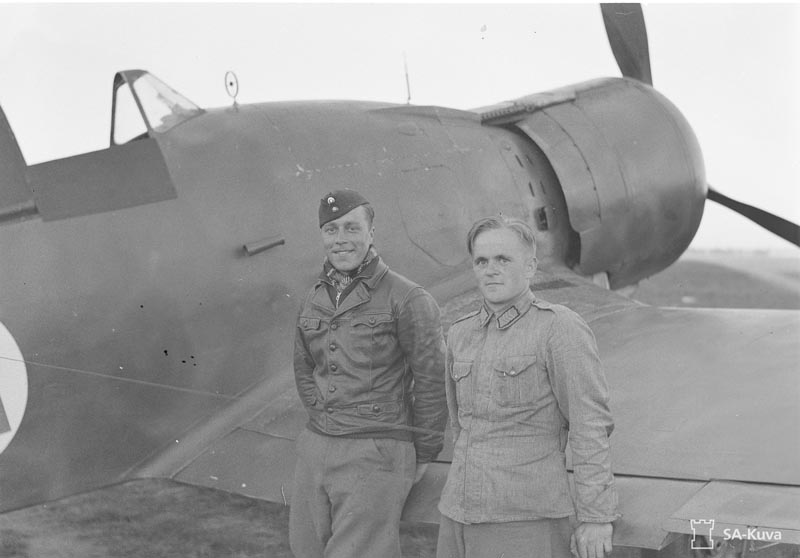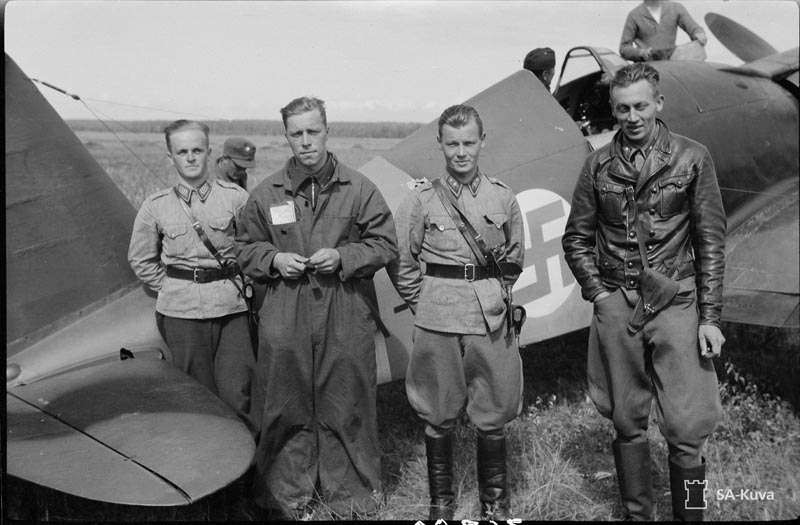Finland

Ylikersantti Sulo Aarne Suikkanen
Finland

Ylikersantti Sulo Aarne Suikkanen
26 January 1917 – 7 August 1944

Vääpeli Lasse Aaltonen and kersantti Suikkanen (right) on 25 June 1941.
Source SA-Kuva.
Sulo Suikkanen was born in Rautu on 26 January 1917.
He received flying training in 1936-37 at RAOK 3 and AOK 8.
He was assigned to T-LentoR 1 and on 3 February 1940 transferred to T-LentoR 2.
On 15 February, he was transferred to LLv 26 as an alikersantti.
At this time, his detachment of LLv 26 was subordinated to detachment Luukkanen of LLv 24.
In the early morning on 29 February, mladshiy leitenant Viktor Masich of 68 IAP led a three-aircraft group making a reconnaissance mission to the Antrea area. Here they detected the well-camouflaged ice base at Ruokolahti. Over the Finnish air base, Masich claimed one Gladiator and he was able to return with some 80 holes in his fighter. The Gladiator lost was GL-269 of LLv 26, subordinate to LLv 24 (detachment Luukkanen), which was lost due to enemy fighter fire when it returned to Ruokolahti base after a morning alarm mission. The Gladiators had been on an abortive mission together with detachment Luukkanen’s Fokkers and were following in the wake of the Fokkers when a lone Russian I-153 appeared like a wraith and shot down the Gladiator in flames, and was gone as suddenly as it had arrived. The pilot alikersantti Pentti Kosola died of wounds.
At 12:00, the detachment received a message that 21 enemy bombers were heading towards Antrea from the south at an altitude of 16,500 feet. The detachments leader kapteeni Eino Luukkanen was prevented to take off due to a loose starboard ski on his Fokker D.XXI and command was given by him to luutnantti Tatu Huhanantti (6 victories). However, it seems that the control centre had given them wrong information or been referring to an entirely different formation for when the 14 Fokkers and Gladiators of LLv 24 and LLv 26 were climbing out of Ruokolahti field they were trapped in a most unfavourable position when they were attacked by an estimated 40 I-153 and I-16 fighters.
In fact, they were 17 I-16s and six I-153s from 68 IAP, which were returning after the morning’s reconnaissance mission. Twelve fighters were led by major Yakov Gil (I-16) while the remaining eleven fighters were led by Starshiy leitenant D. P. Yefimov (CO of 1 Eskadrilya). In the vicious battle that followed three Gladiators were shot down immediately on take-off. In the low-level combat that followed, the Russians destroyed two more Gladiators and one Fokker. The battle lasted only some fifteen minutes before the Russians withdrew.
Alikersantti Suikkanen (GL-256) succeeded in shooting down one I-16 over Kaukopää at 12:20. Suikkanen also claimed a second I-16 damaged over Imatra at the same time. A third reportedly I-16 hit the trees and crashed. Seven more Soviet fighters were damaged. During the combat luutnantti Tatu Huhanantti (Fokker D.XXI FR-94) was killed together with luutnanttis Aimo Halme (GL-262) and Carl Kristensen (GL-259). Luutnantti Poul Christensen (GL-261) and vääpeli Olavi Lilja (GL-268) parachuted to safety but both were injured and Christensen was burnt in his face and hospitalized for the rest of the Winter War. Vääpeli Jussi Tolkki (GL-263) had a remarkable escape by falling into a snow bank when his fighter disintegrated just above the trees.
The returning Soviet pilots claimed eleven “Bulldogs” and eight Fokker D.XXIs (one additional claim for an enemy fighter with an unknown pilot). Major Gil claimed one Fokker in a head on attack. The enemy fighter caught fire, overturned and came down. Gil’s second claim was a Bulldog, which got on the tail of leitenant Aleksandr Polukhin (I-16). This Bulldog also caught fire and went to the ground. Starshiy leitenant Vladimir Plotnikov (I-16) attacked a Bulldog, which got on major Gil’s tail. The Bulldog began to smoke, lost control and crashed to the ground. Starshiy leitenant Ivanov attacked and shot down one Bulldog, which got on starshiy leitenant Plotnikov’s tail. The Bulldog smoked heavily and went to the ground. Leitenants Pavel Sorokin (I-16) and Nikitin (I-16) attacked a Fokker, which caught fire and fell out of control from an altitude of 3200 metres. Starshiy leitenant Dmitriy Yefimov (I-16), leitenant Shishov, leitenant Terpugov, leitenant Viktor Orlov (I-16) and leitenant Aleksey Sapozhnikov (I-16) together claimed a Bulldog, which caught fire and crashed to the ground from an altitude of 70-100 metres. Leitenant Shishov then saw one Bulldog flying at 100 metres altitude, attacked it at high speed, overtook it, then turned back and attacked it again. The Bulldog began to smoke and crashed to the ground. Leitenant Orlov dived on the tail of a Bulldog that flew just over the ground and with fire forced it to crash to the ground. Leitenant Polukhin and mladshiy leitenant Ivan Mazurenko (I-16) saw a Fokker, which attempted to attack their flight. With a swift turn they got onto the enemy’s tail and shot it down with an attack from two sides. The enemy caught fire and crashed to the ground. Mladshiy leitenant Mazurenko then saw a Fokker got behind his tail. With a heavy slideslip, he turned his aircraft 45-50 degrees and the Fokker overtook him. Mazurenko turned back and with a long burst downed the enemy. The Fokker caught fire and crashed to the ground. Mazurenko’s aircraft returned with 36 bullet holes. Leitenant Aleksandr Platonov pursued one Bulldog and with an attack from behind, he forced it to dive. Platonov followed it and continued to fire until the Bulldog got into a spin and crashed into the ground. After the attack of the airfield, leitenant Viktor Popov was climbing for altitude when he saw a Bulldog chased by I-16s and I-153s. With a spilt-S, the Bulldog evaded their attack but Popov attacked it when it was recovering from its dive. Popov fired on it and it caught fire. While climbing for altitude, leitenant Sergey Mayev (I-16) saw a Fokker, which got behind an I-16 and began to fire. Mayev attacked the Fokker from behind and set it on fire. The Fokker crashed to ground out of control. Mladshiy leitenant Vasiliy Soldatov dropped bombs on the enemy aircraft parked on the frozen lake. After that he was attacked by two Fokkers, bus using the manoeuvrability and climbing performance of his I-153, he evaded the attack and climbed to the Soviet group. He saw that one Fokker was pursuing an I-16 and decided to attack it. The enemy decided to outrun him, but Soldatov manoeuvred behind it and fired several long bursts. The enemy aircraft went into a dive. Soldatov followed it and observed that the Fokker crashed into the forest. Leitenant Konyukhov shot down one Fokker in a head on attack. For some reason the enemy aircraft didn’t return fire. The Fokker began to smoke and hit the ground out of control. Leitenant Nikitin twice attacked a Bulldog and shot it down. It fell into the forest and caught fire. Having approached the target, starshiy leitenant Ivan Fedorov, saw one Bulldog at 2200 meters altitude. Fedorov got behind it and with two bursts shot it down. The Bulldog dived vertically and fell north of Salvisaari Island. After that, Fedorov dropped the bombs on one Fokker, which was taxiing on the lake. Just after taking off, this Fokker caught fire and hit the ice.
68 IAP lost one I-16 flown by starshiy leitenant Yefimov (CO of 1 Eskadrilya), who was killed when his I-16 didn’t level out from a steep dive to evade chasing enemy Finnish fighters, but crashed to the ground and one I-153 (c/n 521) were the pilot, mladshiy leitenant Mikhail Ivanovich Volosevich (2 Eskadrilya), parachuted at Tainiokoski to become a PoW.
This combat was the biggest single aerial defeat suffered by the Finns during the whole course of the Second World War.
On 1 March, he was promoted to kersantti.
He continued to serve in LLv 26 during the Continuation War, flying the Fiat G.50.
On the first day of the Continuation War on 25 June 1941, LLv 26 had been flying air combat patrols all morning. A swarm of luutantti Lauri Hämäläinen’s 2nd Flight had just landed at Joroinen 15 SBs of 72 SBAP attacked from 1,000 meters at 11:45. Despite being low on fuel, two Fiats took off amidst the falling bombs and caught the attackers. One of the Fiats was flown by kersantti Suikkanen (FA-15) who took off at 11:30 and landed again at 11:45. In his attack, he claimed one and one shared SB in the Tuusmäki – Haukivesi area.
Meanwhile luutnantti Urho Nieminen, who had led the six G.50s of 3/LLv 26 unnoticed passed the bombers without spotting them, was immediately called back to his base by radio. Diving on the bombers from a superior height at 11.55, the Fiat pilots totally claimed 13 bombers in flames in just 20 minutes (including Suikkanen’s claims). Nieminen described the combat:
“I engaged with my flight 15-20 aircraft strong SB formation above Tuusniemi. With the over speed gained from the altitude we got straight into the business. I shot at two aircraft on the right flank (both engines on fire). I improved two smoking cases. At Kerisalo Island, I got again into a favourable position behind one SB. Its fuel tanks exploded in the air. The aircraft crashed. I continued to fire at the remaining aircraft. I ran out of ammunition, 4-5 aircraft were still flying in the formation, also the smoking one I had fired at. The planes made independent evasive manoeuvres within the formation and the composition of the formation changed all the time. Own aircraft FA-11.”Nieminen was credited with three victories and vääpeli Valio Porvari (FA-20) was credited with three and one shared between 11:55 and 12:15. Additional bombers were claimed by vääpeli Lasse Aaltonen (FA-33) (one and one shared), vänrikki Sakari Kokkonen (FA-21) (one and one shared), kersantti Ilmari Pöysti (FA-5) and ylikersantti Onni Paronen (FA-6).
On 13 July 1941, he was promoted to ylikersantti.

From left to right: Ylikersantti Suikkanen, vääpeli Lasse Aaltonen, luutnantti Linnamaa and vänrikki Lipsanen at Lunkula on 10 August 1941.
Source SA-Kuva.
On 13 August 1941, LLv 26 escorted an artillery fire-control aircraft over Aunuksenjoki, south of River Tuulos, Lake Ladoga.
At 14:00, when luutnantti Lauri Hämäläinen’s (FA-3) swarm (kersantti Ilmari Joensuu (FA-35), alikersantti Klaus Alakoski (FA-28) and ylikersantti Suikkanen (FA-18)) was changing the shift with luutnantti Olli Puhakka’s (FA-1) swarm (vänrikki Eero Enroth (FA-3), lentomestari Lauri Lautamäki (FA-26) and one unknown pilot), nine I-153s of 195 IAP and 197 IAP attacked the fire controller. In five minutes of combat, the eight Fiats claimed all Russians. The victories were claimed by Hämäläinen, Joensuu (one and one damaged), Alakoski, Suikkanen (two I-153s), Puhakka (two I-153s), Enroth and Lautamäki. Puhakka initially claimed one damaged and one destroyed, but the Air Force HQ recorded it as two destroyed:
“At Hoski, I saw two I-153s at about 200 m altitude, I attacked and shot the latter quite close and saw the bullets hit the fuselage. Then I saw two more above me and pulled up. When I looked back to the scene, I saw already two Fiats having attacked and saw one I-153 parting company and sliding to southeast. It came down at Alavoinen and catching fire. After that I tried to get behind the tail of another. The other two were already fired at by other Fiats. The whole battle occurred in a small area. When I finally got behind one and shot very near, I saw after pulling up and going down again that no Chaikas remained. My plane was FA-1.”Hämäläinen’s swarm’s mission lasted from 13:00-14:10 while Puhakka’s swarm’s mission lasted from 13:45-14:45.
On 11 June 1942, he was promoted to vääpeli.
Suikkanen was assigned for twin-engined training at T-LeLv 17 on 6 January 1943.
He was transferred to LeLv 44 on 26 March 1943.
On 7 August 1944, he was killed in an accident.
At the time of his death, Suikkanen had claimed 1 biplane victory and a total of 4.
During his career, he had been decorated with the Vapauden Mitali 1st Class and 2nd Class and the Vapauden Risti 4th Class twice.
Claims:
| Kill no. | Date | Time | Number | Type | Result | Plane type | Serial no. | Locality | Unit |
| 1940 | |||||||||
| 1 | 29/02/40 | 12:20 | 1 | I-16 (a) | Destroyed | Gladiator II | GL-256 | Kaukopää | LLv 26 |
| 29/02/40 | 12:20 | 1 | I-16 (a) | Damaged | Gladiator II | GL-256 | Imatra | LLv 26 | |
| 1941 | |||||||||
| 2 | 25/06/41 | 11:30-11:45 | 1 | SB (b) | Destroyed | Fiat G.50 | FA-15 | Tuusmäki-Haukivesi | 2/LLv 26 |
| 25/06/41 | 11:30-11:45 | ½ | SB (b) | Shared destroyed | Fiat G.50 | FA-15 | Tuusmäki-Haukivesi | 2/LLv 26 | |
| 3 | 13/08/41 | 13:00-14:10 | 1 | I-153 (c) | Destroyed | Fiat G.50 | FA-18 | Tuulos-Aunus | LLv 26 |
| 4 | 13/08/41 | 13:00-14:10 | 1 | I-153 (c) | Destroyed | Fiat G.50 | FA-18 | Tuulos-Aunus | LLv 26 |
Biplane victories: 1 destroyed, 1 damaged.
TOTAL: 4 and 1 shared destroyed.
(a) Claimed in combat with 68 IAP, which claimed 20 enemy fighters (11 Gladiators and 8 Fokker D.XXIs) while losing 2 I-16s. LLv 24 and LLv 26 claimed 2 and 1 damaged I-16s while losing 1 Fokker D.XXI and 5 Gladiators.
(b) Claimed in combat with SBs from 72 SBAP. LeLv 26 claimed 12-13 SBs in this combat of which 9 are acknowledged by Soviet records.
(c) Claimed in combat with I-153s from 195 IAP and 197 IAP. LLv 26 claimed nine victories but it only seems that 195 IAP lost two I-153s (Leytenants I. D. Vinogradov and A. F. Ilyin KIA) and 197 IAP lost one (Leytenant K. F. Meshalkin KIA).
Sources:
Englantilaiset Hävittäjät - Keskinen, Stenman, Niska
Finnish Aces of World War 2 - Kari Stenman and Kalevi Keskinen, 1998 Osprey Publishing, London, ISBN 1-85532-783-X
Ilmavoitot, osa 1 - Kalevi Keskinen and Kari Stenman, ISBN 952-99432-8-8
Ilmavoitot, osa 2 - Kalevi Keskinen and Kari Stenman, ISBN 952-99432-8-8
LeR 2 - Kalevi Keskinen and Kari Stenman, 2001 Suomen Ilmavoimien Historia 17, ISBN 951-98751-0-7
Red Stars 7 - Talvisota Ilmassa - The Winter War In the Air - Carl-Fredrik Geust, 2011 Apali Oy, Tampere, ISBN 978-952-5877-04-5
Soviet Fighter Pilots 1936-1953 - Mikhail Bykov
Suomen Ilmavoimat part II – 1928-40 – Kalevi Keskinen and Kari Stenman, 2006, ISBN 952-99743-0-2
Suomen Ilmavoimat part III – 1941 – Kalevi Keskinen and Kari Stenman, 2007, ISBN 978-952-99743-1-3
Additional information kindly provided by Carl-Fredrik Geust, Lars Larsson, Tuomo Lukkari and Mirek Wawrzynski


